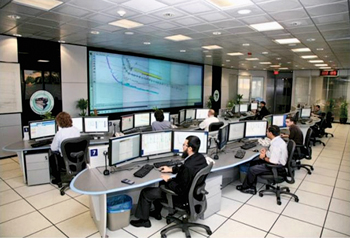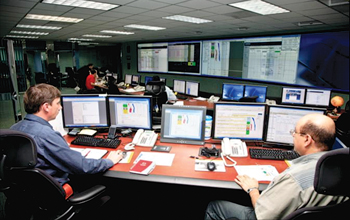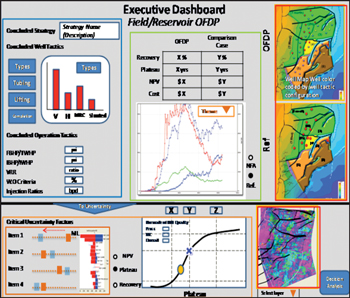ADEL A. AL-QAHTANI, MARTIN F. HOGG, KENNETH K. LAU and NASER A. AL-NASER, Saudi Aramco
Application and adoption of collaboration centers in the upstream industry has increased significantly over the past decade. Saudi Aramco has established a number of collaboration centers that capitalize on large-scale, multi-disciplinary and value-added technical and business collaborations. These centers cover areas of exploration, geosteering, real-time drilling, field development, production and intelligent field management. Tangible economic and technical benefits encompass improved recovery, improved technical workflows, technology innovation, enhanced staff skill set development, and significant reduction of critical field development study cycle times. This case study outlines Saudi Aramco’s experience from five years of utilizing multidisciplinary collaboration workrooms, as well as a “checklist” methodology for collaboration center design, layout, support and maintenance, incorporating continuous technology advancement and multidisciplinary complexity.
For the purpose of this article, a collaboration center is defined as a permanent, dedicated physical space utilized by a team working to fulfill a common, often complex, time-critical study objective. It is a high-impact (e.g., critical safety and business decisions) company asset that undertakes multiple, and generally, parallel activities, including data retrieval, data validation, model building, simulation, prediction, production optimization, well intervention and operational development decision-making.
COLLABORATION CENTERS
Saudi Aramco has established a number of collaboration centers to accelerate delivery of, and improve the quality of time-critical, interdependent, complex, technical, economic and operational decisions. These centers also significantly shorten the professional skills development cycle for rapid and complex cross-disciplinary project decisions. Three collaboration facility categories are employed: Real-Time Operations Centers, Multidiscipline Integration Centers and Training Centers.
REAL-TIME OPERATIONS CENTERS
The Geosteering Operations Center (GOC, Fig. 1) was one of Saudi’s Aramco’s first collaboration centers. Established in 2005, GOC provides expertise to monitor, analyze and model the optimal placement of horizontal and multilateral wells for maximum reservoir contact. Designed to concurrently monitor up to 75 drilling rigs, the GOC has a wide variety of software, hardware and visualization technologies.1 The GOC, as a 24/7 facility, actively monitors thousands of feet of drilled reservoir section annually, including the consuming and analyzing of a large volume of real-time data (e.g., MWD and LWD) feeds on a minute-by-minute basis.
 |
| Fig. 1. Geosteering Operations Center (GOC) |
|
Established in 2006, the Exploration Operations Room (EOR) provides centralized wellsite geology expertise for strategic upstream projects. Equipped with state-of-the-art geological technologies, the EOR monitors and provides real-time decision analysis (formation evaluation, mud logging, etc.) of key exploration and development well decisions, including casing point, coring and DST selection, plus centralized daily well reporting and well decision management.
The Real-Time Drilling Operations Center (RTOC) Fig. 2, provides centralized drilling operations expertise to lower and quickly resolve non-productive drilling-related incidents, such as stuck pipe, borehole instability, tight hole, etc. Established in 2008, this 24/7 facility can support more than 40 concurrent drilling rigs.2 The RTOC has a wide spectrum of leading analysis techniques and technologies to consume, analyze and model a large volume of real-time (e.g., MWD, LWD, directional, drilling fluids, temperature, pressures, etc.) data feeds to achieve improved, time-critical well management decisions.
 |
| Fig. 2. Real-Time Drilling Operations Center (RTOC) |
|
MULTIDISCIPLINE INTEGRATION CENTERS
Saudi Aramco established the Event Solution collaboration facility in 2006, for major, multidisciplinary, optimized field development plans (OFDP). It completes complex projects in weeks rather than in years, with increased clarity on uncertainty, optimization and risk mitigation.3 Deliverables include best-in-class OFDP workflows and technology innovation4 through synergized reservoir characterization, reservoir understanding, simulation and modeling.
Located in Saudi Aramco's Dhahran headquarters, the Intelligent Field Centers are an integral component of a large field and well instrumentation/automation initiative.5 Inaugurated in 2009, two intelligent field collaboration facilities provide a dedicated environment for management and technical experts to remotely view, analyze, model and initiate reservoir production (well and field level) optimization decisions.
TRAINING CENTERS
Saudi Aramco has many training centers (e.g., Leadership Center, Microcomputer Training Center, Industrial Training Center). Opened in 2010, the Upstream Professional Development Center (UPDC) is an advanced knowledge management and expertise collaboration facility that integrates formal classroom training with relevant work experience, plus responsive, progressive mentoring and access to all relevant computer-based learning and knowledge-based resources. Simulating the work environment and integrated workflows is fundamental to UPDC. Designed to train more than 500 professionals, UPDC incorporates an array of leading and Saudi Aramco proprietary technology and expertise, focusing on business-critical work.
BENEFITS
Saudi Aramco’s collaboration centers deliver a high level of technical and business improvement in specific tasks. Accordingly, the company has realized, developed and experienced a number of industry-leading process, organizational, operational and technology support benefits that would not have materialized without adopting and applying collaboration facilities.
Several examples include:
-
Higher-quality project deliverables and significantly shortened, project-critical decision cycles. For example, deliver major, optimized field development projects in months, with increased clarity on uncertainty and risk mitigation.3
-
Higher-quality and industry-leading technology and workflow expertise. For example, the Roll-Up initiative was adopted as a new integrated reservoir studies industry standard. This initiative provides executive and management dashboards (Fig. 3) to easily explore, display and contrast study results and alternative development scenarios.4 Another example is the Drilling Real Time Data Hub7, which is a data management and exchange solution for real-time drilling and completion data, based on WITSML.
 |
| Fig. 3. Executive Dashboard of Roll-Up Initiative4 |
|
-
Enhanced intra-collaboration facility workflows and technologies. These properties serve as a key foundation step toward advanced inter-collaboration initiatives, such as real-time reservoir simulation and Real Options.5
-
A lowered risk and high-impact mechanism to continuously introduce, adapt and grow organizational, technical and resource improvement. This is done without the need for a major company-wide organizational change, and/or refit as generally applied in most industries.
-
Accelerated, effective adoption of innovative technology and processes. Collaboration facilities are ideal for new technology and processes, providing immediate operational feedback and refined improvement deployment plans.
-
An enhanced, accelerated learning, training and development environment. Collaboration facilities are a core petro-technical skills set development asset, exemplifying multidisciplinary team work, motivation and communication.
-
Cross-industry collaboration. A premium mechanism for the development of joint industry technology initiatives.
LESSONS LEARNED
Saudi Aramco’s facilities have given rise to a number of lessons learned in designing and supporting smart upstream collaboration centers. Accordingly, the ability to incorporate these lessons early is a critical success factor in the management and operation of current and future collaboration centers.
Collaboration facilities stimulate technology and workflow innovation initiatives. These are high-impact catalysts that stimulate step change improvements (e.g., technology, process, organization and ownership) beyond the original obligatory project deliverables. The Roll-Up initiative is an example.4
An annual technology (software and hardware) and consulting fund is a must. This fund is critical to address and bridge potential project delivery gaps associated with new, previously not encountered and/or unforeseen, critical, project work tasks. Alternatively, one should avoid and minimize the non-availability of technology and or consulting solutions.
A major facility and technology refurbishment work program is likely every three to five years. Technology evolution, combined with changing organizational, human resource and business management requirements, generally outgrows the original facility design and technology scope. This is particularly true for evolving and innovative initiatives, like the emergence and availability of HD-quality and 64-bit technologies, unified cross-disciplinary technologies, virtual collaboration, etc.
Collaboration leads to adoption of industrial standards, such as WITSML. It allows the leveraging of investment in highly instrumented fields to enable new automation and optimization that would otherwise be impossible or difficult to achieve. Also, it reduces the cost of information exchange between Saudi Aramco and software service companies, and it reduces the cost of replacing or substituting software to improve functionality.
Cross-disciplinary technology and workflow, and unified data access are critical, core collaboration facility success factors. The opportunity for all facility participants and project stakeholders to easily access, share, visualize, analyze and contribute to all project work tasks and decisions, irrespective of seniority, expertise and discipline is a must. This does not lessen nor remove the requirement for discipline specialist content. Rather, this factor strengthens the opportunity for higher project quality, content and detail.
The availability of a technology, data and operating systems support professional as a full-time collaboration team member is critical. Since collaboration facilities are high-impact, high-cost and time-critical company assets, minimal facility downtime is a must. Having an embedded, multidisciplinary, petrotechnical support professional with equal project delivery accountability is important and indispensible.
A strong, dedicated management staff drives success. Collaboration facilities are major capability transformation assets that do not run themselves without sustained executive and senior management endorsement, both in funding and leadership, not least the critical development of professional mutual respect and trust between various end-users and specialists.
Benchmarking and flexible support processes allow for process evaluation. Development of standard Key Performance Indices (KPIs) provides a means of measuring performance, utilization, customer activities and achievements of collaboration centers. The nature and pace of collaboration center activities dictate a responsive, active support model, including administration, organization, contracting, data access, staffing, technology access, etc.
THE FUTURE OF COLLABORATION CENTERS
Saudi Aramco has successfully designed, built, used and benefited from a wide range of collaboration facilities. Activities have largely focused on improving and refining collaboration optimization within specific work tasks. The next step in the development of future collaboration centers will focus on inter-collaboration facility initiatives including organizational, operational, technology and workflow improvement opportunities.5
The rapid advance of more robust video and audio digital communication devices has led to the establishment of virtual collaboration centers. They are being utilized in a number of companies (e.g., BP and Shell). The advantages that led to their usage in place of physical centers are obvious—no need to duplicate physical centers at multiple locations; team members can collaborate at any time irrespective of physical geographic location; and a reduction in hardware and software costs.
A successful collaboration facility includes a dynamic technology and resource profile with sustained executive sponsorship. Collaboration facility utilization will continue to grow and evolve with changing business requirements, e.g., real-time simulation and Real Options. We foresee virtual collaboration through advanced, emerging technologies as a potential opportunity for geographically dispersed experts to remotely contribute to critical collaboration work tasks. 
|
Checklist for Successful Collaboration Centers
Our experiences in establishing and supporting collaboration centers gave rise to the following checklist, which is essential in planning, designing and building effective, successful collaboration centers.
Design
- Define the scope of the center
- Determine the type of workflow to be applied
- Map the process used for selecting products and technologies
- Define the stakeholders, and the roles and responsibilities of each
- Determine the class of the center
- Fast loop (seconds to days): e.g., control room decisions
- Medium loop (hours to months): e.g., planning of operations on integrated offshore platforms
- Slow loop (months to years): e.g., optimizing secondary recovery
- Determine type of center to build (physical, virtual, hybrid)
Identify available IT infrastructure
- Define core (e.g., software and hardware) and helper technology (e.g., audio and control tools) to match defined workflow
- Select appropriate organizational structure to follow (functional, process-based, matrix)
- Make users, themselves, and or a third party participate in the design phase, to ensure optimization and full utilization
- Allow an adequate space for desktops, storage, meetings, etc.
- Have breakout rooms for meetings, training, consultation, etc.
- Allow for room and video system reconfiguration
- Design or select ergonomic furniture
- Define size, type and resolution of data display devices
- Centralize audio/video control
- Incorporate climate, lighting and noise level control
- Use a wireless floor to have a safer environment
Technology & Processes
- Make provision to allow for changes in technical requirements
- Adopt integrated applications
- Adopt advanced visualization systems (video wall, LCD screens, touch screens, desktop camera, sympodium, etc.)
- Capitalize on the use of high performance computing
- Attend to various aspects of data backup and data security
- Leverage the availability of real-time data
- Have good data management and communication among different assets and domains
- Have a common data repository
- Identify the digital network to which technology is integrated
- Capitalize on the advanced monitoring and surveillance capabilities
Management and Technology Support
- Introduce and support new technology more effectively
- Have dedicated staff for hardware and software support
- Incorporate workflow/procedures to keep up with the development of new technology
- Plan for and minimize down time
- Budget for hardware, software and furniture upgrades
- Incorporate KPI to access performance
|
ACKNOWLEDGMENT
The authors would like to express their thanks and appreciation to Saudi Aramco management for permission to publish this article.
LITERATURE CITED
1. Al-Hamad, Mohammed A. and Celestine S. Vettical, “E&P operational innovation with real-time collaboration and exception management,” SPE 123197, presented at SPE Digital Energy Conference & Exhibition, Houston, Texas, USA, Apr. 7-8, 2009.
2. Khudiri, M.M., N. A. Naser, M. A. Alshehry, and A. A. Nassir, “Saudi Aramco RTOC, collaborative, safe and effective delivery of wells from start to finish,” SPE 125339, presented at SPE/IADC Middle East Drilling Technology Conference & Exhibition, Bahrain, Oct. 26-28, 2009. Elrafie, E., J. White, F. Awami, “The event solution, a new approach for fully integrated studies covering uncertainty analysis and risk assessment,” SPE 105276, presented at the 15th Middle East Oil & Gas Show and Conference, Bahrain, March 11-14, 2007.
3. Elrafie, E., M. Hogg M. and H. Mohammadi, “Integrated reservoir studies Roll-Up Initiative,” SPE 138551, presented at the Abu Dhabi International Petroleum Exhibition, Abu Dhabi, Nov. 1-4, 2010.
4. AbdulKarim, A., T. Al-Dhubaib, E. Elrafie, E. and M. O. Alamoudi, “Overview of Saudi Aramco’s Intelligent Field Program,” SPE 129706, presented at the Intelligent Energy Conference and Exhibition, Utrecht, The Netherlands, March 23-25, 2010.
5. Goodwin, S., A. Ford, P. Griffiths, K. Moore-Cernoch, and P. Williams, “Advanced collaboration environments – The growth of a capability transformation program,” SPE 128650, presented at the Intelligent Energy Conference and Exhibition, Utrecht, The Netherlands, March 23-25, 2010.
|





